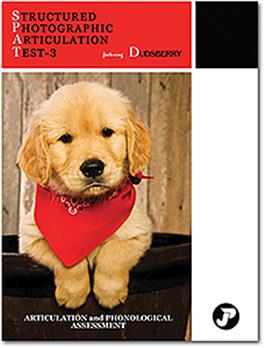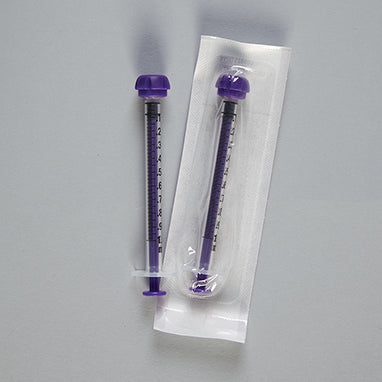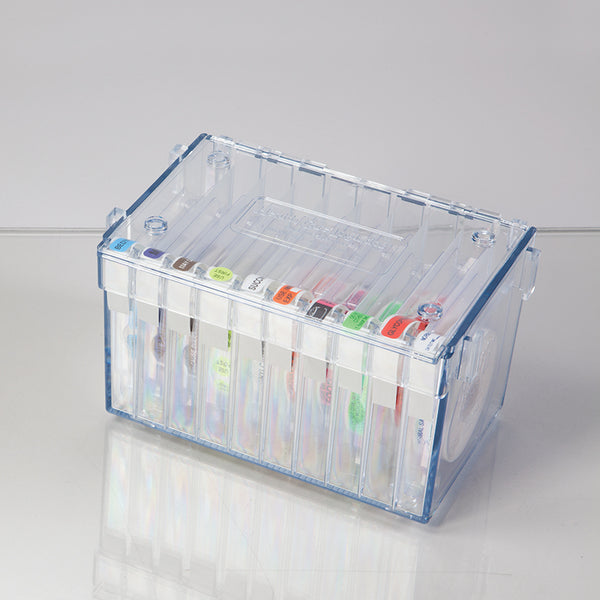
The Structured Photographic Articulation Test featuring Dudsberry
Product Code : MPS8-14238
Vendor: Vasyli
Available
Description
NOW AVAILABLE!
Strong Quantitative and Qualitative Features; Exceptional Tool for Assessing Production in Complex Contexts; Excellent Resource for Use with Linguistically Diverse Speakers
Ages: 3 through 10Testing Time: 15 minutes
More than 35 years since the introduction of Dudsberry, the Golden Retriever puppy, at the 1988 ASHA Convention in Boston, this popular articulation assessment, Structured Photographic Articulation Test, has once again been revised to provide clinicians with not only a reliable quantitative tool but also a means to gather important qualitative information to aid in assessing the speech production skills of children ages 3 to 10. Data gained from the various quantitative and qualitative aspects of the SPAT-D 3 can be used for qualifying a child for services as well as developing treatment goals, monitoring progress, and determining dismissal.
The 5-year development process resulted in the new edition of Structured Photographic Articulation Test, SPAT-D 3, providing normative data based on a sample of over 2,400 children reflecting the most recent U.S. census data. Quantitative analysis of 65 singleton consonants and 17 consonant blends at the word level are elicited by 36 color photographs of Dudsberry interacting with objects that contain the target phonemes, allowing for calculation of standard scores, confidence intervals, percentile ranks, and percentile bands. Determination of a child s consonant inventory, percent of consonants correct, word shape knowledge, and presence of phonological patterns as well as evaluation of vowel production all provide valuable qualitative analyses at the word level.
Additional qualitative features of SPAT-D 3 include consistency in sound production and intelligibility in connected speech utilizing the story of Dudsberry s Day at School, two Multisyllabic Word Screeners (Basic and Advanced) for qualitative assessment of consonants in complex contexts to aid in gathering data regarding the stability of sound production in more complex sound contexts and goal formulation for older children, and resources to provide an in-depth guide for the influence on English production of the six most prevalent languages/dialects spoken in the United States to help determine a speech difference versus a true speech disorder.
New Features
- Assessment of Complex Contexts empirically linked to reading deficits (Kamhi & Catts, 1991):
- Most words used in standardized assessment tools are one to two syllables; although appropriate for diagnosing a speech sound disorder, these contexts may be not be as useful when considering discharge.
- Two levels of Multisyllabic Word Screeners to help evaluate whether children who have received services for speech sound disorders (phonological or articulation) and appear ready for discharge have the phonological skills necessary to meet grade-level expectations set forth by the Common Core State Standards (CCSS) in Speaking and Listening as well as Reading and Writing:
- Basic: Ages 5 7 (picture stimuli)
- 25 target words
- 1 five-syllable, 7 four-syllable, and 17 three-syllable words
- Advanced: Age 8 and older (printed word lists)
- 65 target words
- Words arranged by theme
- Can be used to create unique word lists for children based on their specific sound challenges
- The SPAT-D 3 manual provides an in-depth guide for the influence on English production of the six most prevalent languages/dialects spoken in the United States to help determine a speech difference versus a true speech sound disorder.
- Languages/dialects
- African-American English
- Arabic
- Mandarin
- Spanish
- Tagalog
- Philippine
- General background on each language/dialect
- Presentation of shared phonemes and general patterns of typical deviation to aid in differentiating typical versus atypical influence on English speech
- Specific examples and considerations for interpreting performance on the SPAT-D 3 for each targeted language/dialect
Highlights
- Normative tables for ages 3:0 9:11 are based on a national sample of over 2,400 children from the four geographical areas specified by the current U.S. Census Bureau.
- ASHA-certified clinicians tested children from rural, suburban, and urban areas.
- Thirty-six 4"" x 6"" real-life color photographs of Dudsberry in a photo book serve as stimuli to spontaneously elicit the word-level production of 65 single consonants and 17 consonant blends.
- Standard scores, confidence intervals, percentile ranks, percentile bands, and test-age equivalents for females and males, ages 3 to 10, are provided.
- Validity, reliability, sensitivity and specificity, positive and negative likelihood ratios, and bias data are included, and support the use of SPAT-D 3 as part of the assessment protocol for a child suspected of a speech sound disorder.
- A color-coded response form enables the examiner to immediately analyze articulation errors according to syllabic function and manner of articulation. No whole-word transcription is necessary.
- Response form includes sections for recording consonant inventory, percentage of consonants correct (PCC) and PCC-Revised, word shapes, and vowels inventory.
- Common phonological processes can be assessed.
- Phoneme production in connected speech can be additionally assessed utilizing the story of Dudsberry s Day at School (8 photos) to determine consistency in sound production across contexts (word-connected speech).
- Multisyllabic Word Screeners target syllable fidelity and stress in addition to sound production and stability.
- Separate response form for Multisyllabic Word Screeners is provided.
Administration Time
- Administration of the quantitative (standardized) portion of SPAT-D 3 takes approximately 15 minutes. A color-coded response form allows for quick and easy scoring.
- Administration of optional qualitative portions of the test will vary based on the unique profile of the child and the clinician s purpose in administering the testing.
COMPLETE SPAT-D 3 KIT INCLUDES: Examiner s Manual, 44 Color Photographs (4"" x 6"") in a Bound Album, 30 Response Forms, Laminated Page of Eliciting Statements, and Laminated Multisyllabic Basic Screener Photo Sheet, all in a sturdy storage box. (2016)













